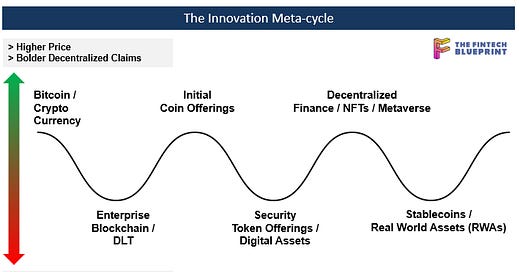Long Take: The $2B of tokenized Real World Assets (RWAs) trading onchain in 2023
As well as another $100B in stablecoins, and $2B of MakerDAO RWA treasury
Gm Fintech Architects —
Today we are diving into the following topics:
Summary: Today we consider the trend of tokenized Real World Assets, and put them into broader context for the industry. We look at the evolution of institutional tokenized finance, from DLT to STOs to RWAs, and show the quantitative metrics and growth over the last year by the relevant asset classes, from stablecoins, to treasuries, to private credit. Finally, we parse the key participants in the space and compare them to the fintech digital lending generation of old.
Topics: stablecoins, RWAs, private credit, digital lending, Franklin Templeton, Maple Finance, Goldfinch, Ondo, Centrifuge, OnDeck, Lending Club
If you got value from this article, let us know your thoughts! And to recommend new topics and companies for coverage, leave a note below.
Long Take
The Crypto Finance Innovation Cycle
Today, we want to refresh the topic of Real World Assets (RWAs) in Web3 — not to be confused with Risk Weighted Assets (RWAs) in global banking. But before finding the latest market sizing, let’s place things in their context. You hang around for a while in this fintech business, and tech innovation patterns start to look pretty clear.
The initial push for the space were the great sins of 2008 and Alan Greenspan, resulting in the launch of Bitcoin and the digital gold narrative. Cryptocurrency was meant to replace our fragile, slow, corruptible fiat money.
Yet as the markets crashed and Silk Road collapsed, a new story emerged — not Bitcoin, but Blockchain. Enterprise distributed ledger technology would anchor institutional finance, which in turn would upgrade the spaghetti code powering every finance vertical, from banking cores, to portfolio management, to the card network rails. Enormous capital went into this, only to see progress die in years of consortia attempts and proofs of concepts.
ICOs grew quickly on Ethereum, which had proven to be a better capital formation platform than every single equity crowdfunding fintech before it. Money pooled into moonshot ideas and various scam black holes. It was fun while it lasted, but then it wasn’t fun as people lost their shirts, and issuers were chased around by the SEC for illegal securities offerings.
Which brings us to the counter reaction — not ICOs, but STOs. If the tokens were securities, and duly regulated by the SEC, surely everyone would be happy to own those? Wouldn’t you want a slice of private equity or real estate, instead of a low quality venture PowerPoint and a smart contract that steals your money? But it turned out that No, nobody actually wanted that private equity, because a bigger opportunity was around the corner.
Decentralized Finance took the software of financial manufacturing, and squeezed it into the computational processing power of a Nintendo. It spiked from nothing to $200 billion, only to self-immolate in recursive derivative loops as leverage pulled out. Commerce around digital objects, NFTs, offered a glimpse of the economy that DeFi will bank. Despite all the stress, the machine worked.
Today we sit in the narrative of stablecoins and real world assets. As synthetic DeFi struggled for market value, the digital dollar has sustained interest from investors as the ultimate risk-off asset. Treasuries are tokenized and making their way onchain, and the longer tail of private credit and alternative assets is also getting its time to shine. Banks, being regulated and conservative, are pushing past Proof of Concept into Production. Even those science fiction creatures, DAOs, are diversifying into fixed income and slinging the yield to token holders.
We know the next phase of the bull market — catalyzed by BTC vehicles, developer interest, and a weaker dollar — will bring forward something new. That said, each progressive step is incremental, building on that which comes before it. And RWA is a brick now part of the wall.
The Jigsaw Puzzle
A great report from 21 Shares paints the overall picture.
We will quote from both the report, and the underlying Dune dashboard tracking the data.
The first graphic is a table of tokenized products by the assets they have gathered. Stablecoins backed by dollars, traditional collateral, or bank deposits are the clear winner, with nearly $70B of value. Other stablecoin algorithms exist, but those selected here are anchored by non-crypto assets. Given the various utilities of cash — from risk-off sweep to payments in commerce — we are not surprised to see this category leading. It is not hard to explain why someone should own the dollar.
Within stablecoins, the collateralized game is largely between USDC and USDT. We will bring up Paxos and PayPal’s stablecoins as worthy contenders as well. The below chart from Coinmetrics gives you a rough split, though the totals differ.
But let’s move past these money market fund-type tokens, and look at other asset classes. Have private equity, fixed income, and alternatives really moved on chain? Below is one view, which shows that the adoption of asset class beyond cash is still very, very low. This has to do with the shape of demand, which we will discuss later.
What we are seeing is the integration of around $500MM to 2B of fixed income assets — from corporate bonds, to asset backed finance, to fund vehicles — into token form. This is the taking of bonds sitting in some particular CSD or legal contract, turning them into tokens, and attaching various cash settlement legs between financial institutions and investors.









